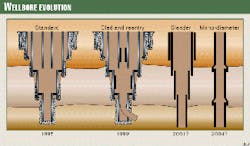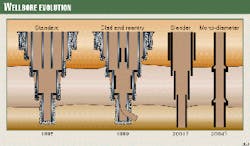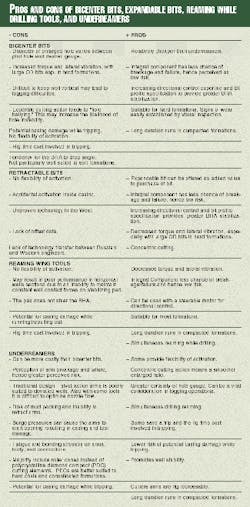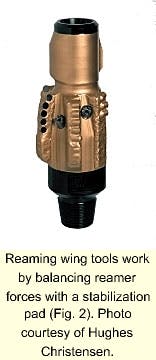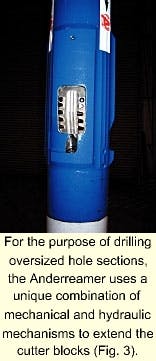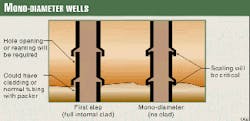Underreaming, a complex market consisting of at least 22 drilling applications, offers several product options, including bicenter bits, reaming wing tools, expandable bits, and underreamers.
Unfortunately, in terms of product selection and application, the variety of available options presents a quandary to the drilling professional (Fig. 1). The information in this article, which is drawn from 52 interviews with employees from 18 operators, six drilling contractors, and four service companies, sheds light on this topic.
Study methodology
The accompanying box provides a list of strengths and limitations for retractable drill bits, bicenter bits, reaming wing tools, and underreamers. Two hole-size categories-171/2 to 36 in. and 43/4 to 171/2 in.-were created to aid in the analysis. This was also intended to identify any trends that may emerge as to product preference and hole size.
Because of the technical differences between hole openers and underreamers, hole openers have been excluded from the market analysis. Hole openers start to enlarge an existing pilot hole from the surface of the wellbore and contain fixed cutters of a predetermined diameter.
Conversely, underreamers enlarge the hole below a restricted tubular bore. The cutters are kept closed during the pass-through and are activated once the tool reaches the point that requires underreaming. Turning the pumps off deactivates the cutters with this technology.
Bicenter bits
About 10 years ago, bit manufacturers developed bicenter bits capable of enlarging the hole beneath 95/8 in. to 121/4 in. Gradually, increased demand for these bits highlighted certain technological limitations, including poor directional drilling performance.
Essentially, this was linked to the lack of a full-gauge stabilizer above the bicenter bit, resulting in bottomhole assembly (BHA) stabilization issues. Without stabilization, there was a need to depend almost entirely on the bent motor housing to steer.
BHAs using bicenter bits tended to have a problem with inclination control. Consequently, to make changes in inclination, drillers spent a lot of time slide drilling can be difficult at the best of times, let alone with the added complication of running a bit that is geometrically unstable. From this perspective, there was an understandable apprehension towards running bicenter bits.
As steerability issues continued to hinder directional performance, bicenter bit manufacturers have found ways to improve BHA behavior. These companies realized that bicenter bits could to an extent be steered by weight alone. They also found that longer bit profiles helped to stabilize BHA performance.
Today, bicenter bits are used in hard formations as they are perceived to be more robust than traditional arm underreamers. On the other hand, underreamers tend to be preferred in softer formations as their application can lead to impressive gains in penetration rates while providing an increased time window to conduct operations in swelling formations.
The success of bicenter bits removed the need for hole openers in many applications, eliminating the need to drill the interval twice.1
From the drilling engineers' point of view, a single integral component reduced risk and cost as compared to two or three. All these factors came together to confirm the place of the bicenter bit in the industry.
Promising technologies
At present, the deepwater drilling market remains one of the new frontiers for underreaming applications in which a substantial amount of time is spent drilling the top-hole sections. A typical scenario includes 5 days of rig time at a rig cost of $200,000/day. Underreaming can provide significant time and cost savings in these circumstances.
It appears that Petrobras is leading advances in deepwater drilling with new types of casing. For example, well cladding techniques, which expand a secondary layer of steel over existing casing, are now being developed.
In the West, there has also been a renewed interest in the development of retractable bits by Holte Engineering, Eugene, Ore. In the FSU, Russian engineers at VNIIBT and Aquatic Co., Moscow, have also successfully used retractable bits for oil field casing drilling, ultradeep test wells, and offshore stratigraphic drilling (OGJ, Mar. 8, 1999, p. 55).
It is likely that other leading bit companies are developing the technology as well, while at least one major operator continues to search for this type of technology.
Another technology is the reaming wing tool. This technology features a polycrystalline diamond compact bit with a ream while drilling capability (Fig. 2).2
This tool differs from bicenter bits in that it features a two-piece design, allowing for greater flexibility in pilot bit selection. Directional control is conducted through a steerable motor.
Underreamers
Originally, underreamers were only used to underream previously drilled holes, involving an additional trip. Typical design features included flow or weight-activated arms that expanded on a pivot-bearing mechanism.
An example of the limitations associated with this type of technology can be seen in runs where traditional arm-type underreamers have led to failures, often resulting in a sidetrack.
Reportedly, underreamers have difficulty coping with deviated wells and hard chalk. This has raised concerns regarding the effect of bending stresses on the body and connections.
Another problematic area includes mud packing. When this occurs below the arms, it can prevent them from closing in, making it extremely difficult to pull out of hole.
Historically, these factors have swayed decision making in regards to its use. Even today, underreamers still have a way to go in terms of improving mechanical integrity and shedding a poor image.
To improve the mechanical integrity of traditional arm type underreamers, several things happened. First, the development of polycrystalline diamond compact cutters eliminated problems associate with mud packing and arm breakage. Thus, typical tool life was extended to 10 runs or more.
A further procedural innovation involved the removal of all cutters from worn roller cones, replacing these with new cutters. These cutters were stub-welded in place once fatigue became an issue.
Three-cone underreamers have been capable of enlarging holes by as much as 50%, typically selected according to formation type so as to optimize performance. The tools also allowed full volume circulation at all times.
It is convenient to classify the various reamers as either drilling or reaming types. The reaming type serves only to enlargen an existing hole, involving complete section redrill.
Conversely, the drilling type allows for the simultaneous reaming of a pilot hole as it is drilled. It can also be used to underream existing holes. Its design allows mudflow to be diverted to the bit or can even be used with guidance system such as a bullnose for pilot-hole reentry.
The latter has been reported to give good hold or slight build tendencies, depending on formation and other factors. Thus, its performance resembles a packed-hole assembly.
Recent run data from Andergauge Ltd. show that the Anderreamer provided the predictable characteristics of a near bit stabilizer turning a 62-ft pendulum into a build assembly. A major advantage associated with this tool type is that it saves on tripping operations and is clearly attractive in high-cost drilling environments (Fig. 3).
The future
The three main characteristics of the underreaming market, increased production, cost cutting, and technical innovation in well design show promise for the future. Moreover, strong market drivers in the short, medium, and long term will tend to encourage conditions apt for growth.
Increased production
Increased production is important for two major reasons.
First, depleted reservoirs result in lower reservoir pressures and poorer rock mechanics, further heightening the likelihood of sand productivity. In these instances, to preserve or improve production rates, provision must be made for sand exclusion through prewrapped screens or gravel packs.
Consequently, the need for enlarging holes to place new sand screens and gravel packs also arises. Eventually, the demand for remedial work such as drilling through failed screens will place additional demand on underreaming technologies.
Depleted reservoirs are also likely to result in transition from oil to gas production. As such, the use of underreaming technologies to configure larger bore casing strings can be viewed as a preferred method of improving productivity by maximizing the size of the borehole in the reservoir section of the well.
The bracket of increased production also covers older platforms. Decommissioning has proved to be complicated, time consuming, and expensive. These costs tend to dissuade operators from such activities, enhancing the appeal for extending platform life. This can also heighten demand, as certain technical restrictions can be associated with older platforms.
These restrictions include the availability of conductor slots and the size of blowout preventers, which restricts bit diameters and conductor placement. Both of these examples make underreaming an attractive option, as it overcomes such limitations while maximizing the configuration of casing strings.
Finally, underreaming technologies can be applied towards sidetracking and multilateral drilling applications where hole enlargement through existing casing strings provide an attractive option.
Cost cutting
Several factors are worthy of mention. The first is the potential reduction of the environmental footprint left by drilling and production activities. The second includes a reduction in hole sizes and volumes along with the costs associated with expensive muds, casing strings, and cement (Fig. 4).
This approach can be said to be institutionalized by the North Sea "finderwell" concept, which seeks to reduce the average costs of drilling and exploration imposed by "demanding" Health & Safety Executive legislation requirements.
Third, technical innovation in slender wells also provides a strong mechanism for cost cutting. Allied to slender wells are two novel technologies. These include expandable casing applications in the short to medium term and monobore drilling and completion in the long term.
These novel methodologies are pushing the limits of current underreaming technology. Typical of this push is the encouragement operators are giving "stepping-stone" technologies such as retractable bits and underreamers, vital to the long-term vision of a viable mono-diameter wellbore concept (Fig. 5).
The operational limitations standing between today's capabilities and the ultimate goal of a mono-diameter well, however, are likely to be resolved through the development of solid tubular expansion (STE) techniques.
The adaptation of wellhead design, tree sizing, drill-bit development, and so on, have no commercial justification until expandable technology fully matures, whereas the marriage of STE and underreaming technologies have intermediate applications throughout its development cycle.
Expanded-tube technology relies on forcing an expansion cone through tubulars with oil field proven metallurgies, effecting diameter expansion without adverse mechanical effects. Consequently, diameter and depth restrictions, which operators now face in well construction and repair procedures, should be reduced, increasing the production capacity of individual wells (Fig. 6).
Tubular expansion will then become possible both inside tubulars and in open hole. Application of the technology will allow cost-effective repair of deficient wells while making it possible to repair corroded, perforated, or otherwise damaged tubulars without significant loss of internal diameter.
Tubular expansion will also alleviate lift-design limitations for new wells by allowing an extra casing string without the sacrifice of hole diameter, greatly reducing the need for cementing services.
Earlier this year, e2 Tech successfully completed the final pre-launch system test of an expandable liner system where 250 ft of 51/2-in., 17-lb/ft., 45-ksi yield pipe was expanded into the ID of 7-in., 29 lb/ft casing at 2,370 ft measured depth.
The test was carried out at the Downhole Technology Ltd. test site in Aberdeen. Mechanical expansion occurred in the horizontal section of the mud-filled deviated well by pulling a forming cone through the liner on drill pipe and pulling the string through a 12°/100 ft build radius.
Following the expansion the running tools and anchoring system were successfully recovered to surface pressure tested in the collapse direction to 2,000 psi. At the top and bottom of the expanded liner, integral elastomer seals were incorporated with seven threaded connections along its length.
Acknowledgments
The authors wish to thank R. Urselman of Shell Expro and K. Ellis of Andergauge for their contributions to this article.
References
- Aubin, D.R., Fielder, C.M., and Massey, C.D., "Innovative solutions eliminate directional problems in deepwater programs," SPE paper 38612, presented at the SPE Annual Conference, San Antonio, Oct. 5-8, 1997.
- Shell, J.C., Doster, M., Dykstra, M., and Mcdonald, S., "Development of steerable ream while drilling technology and its application in high angle wells in GOM," IADC /SPE paper 39326, presented at the IADC/SPE Drilling Conference, Dallas, Mar. 3-6, 1998.
The Authors
Wajid Rasheed is responsible for corporate and product marketing at Andergauge Ltd., a company specializing in downhole drilling tools. He joined Andergauge in August 1998 after working on projects for the Ministry of Industry, Energy & Mining, and the European Patent Office in Madrid. Rasheed speaks Spanish, Arabic, and Urdu and holds qualifications in well construction.
Mike Jones is operations manager for e2 Tech Ltd., the expandable-casing joint venture between Baker Hughes Ltd. and Shell Guardian Ltd. Exploration. He received his bachelor's degree in mechanical engineering from the University of Hull, England, in 1989. Before joining Baker Hughes in 1993, he spent 3 years with BP Exploration as a staff petroleum engineer. While with Baker Hughes, Jones worked as an engineer in exploration well testing and sand face completion design, before being seconded back to BP. He joined e2 Tech in February 1999.
Mick Betts currently works in the expandable tubular technology team at Shell International Exploration & Production (SIEP) in Rijswijk, Netherlands. He joined Shell in 1982 and worked in various positions both onshore and offshore in the North Sea, including company drilling supervisor and well engineer. After 5 years in the Far East as a drilling contracts engineer, Betts joined the Reeled Systems group in SIEP, before moving to his current position.
